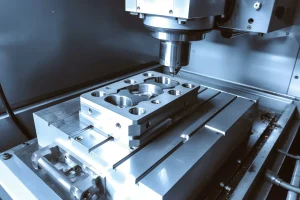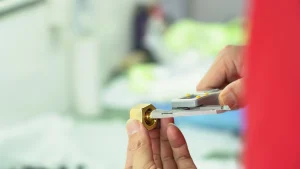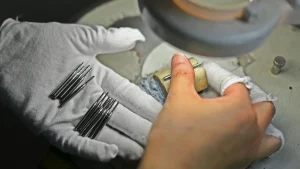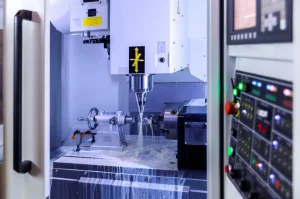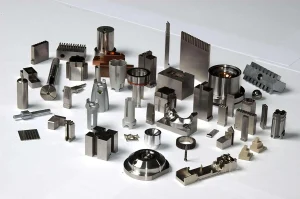Introduction
The Rise of Composite Robot Components
In modern industry, the role of composite robot components has become increasingly prominent. These components, made from a combination of different materials, offer a unique set of properties that traditional materials simply can’t match. They are lighter in weight compared to metal components, which is crucial for robots that need to be mobile and energy – efficient. For example, in the field of logistics, where autonomous mobile robots (AMRs) are used for material handling, the use of composite components can significantly reduce the energy consumption of these robots, allowing them to operate for longer periods on a single charge.
Moreover, composite robot components often have excellent strength – to – weight ratios. This means they can withstand high levels of stress and load while still maintaining their structural integrity. In industrial robots used in manufacturing plants for tasks such as heavy – duty assembly or material cutting, the high strength of composite components ensures the long – term reliability and durability of the robots. They are also more resistant to corrosion and environmental factors than many metals, making them suitable for use in harsh industrial environments, such as chemical plants or outdoor construction sites.
The demand for composite robot components is growing across various industries, from automotive manufacturing to aerospace. In the automotive industry, robots with composite components are used in tasks like painting and precision assembly, where the lightweight nature of the components helps in achieving high – speed and accurate movements. In aerospace, composite materials are used to build robots that can perform inspections and maintenance on aircraft, both on the ground and in – flight, due to their high strength and low weight, which is critical for reducing the overall weight of the aircraft – related equipment. This increasing demand has led to the need for customized processing of composite robot components to meet the specific requirements of different applications.
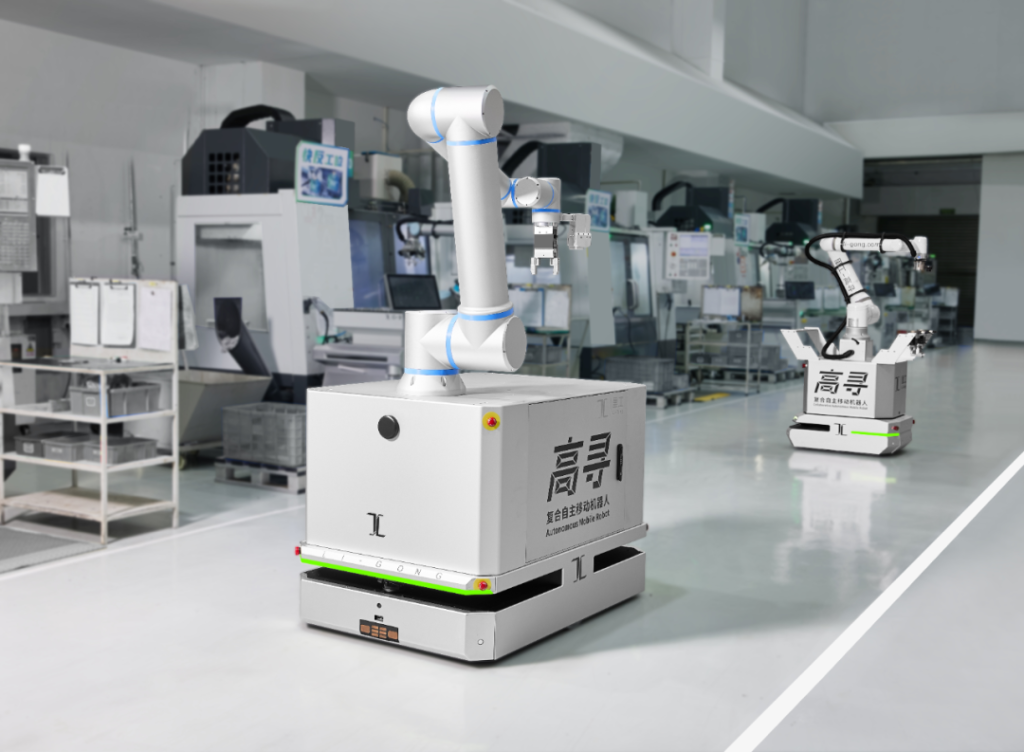
Understanding Drags in the Context
When it comes to the customized processing of composite robot components, “drags” refer to a set of specific requirements or constraints that a customer has. These can include dimensional tolerances, material properties, surface finish requirements, and functional specifications. For example, if a company needs a composite robot arm for a precise pick – and – place operation in an electronics manufacturing facility, the drags might include very tight dimensional tolerances to ensure accurate movement and a smooth surface finish to prevent any damage to the delicate electronic components being handled.
Drags are closely related to composite robot components as they determine the manufacturing process and the final product’s quality. Meeting the drags requires advanced manufacturing techniques and expertise. In the case of composite materials, the processing methods need to be carefully tailored. For instance, if the drags specify a particular fiber – to – resin ratio in a composite material to achieve a certain strength and flexibility, the manufacturing process must be precisely controlled to ensure this ratio is maintained. Any deviation from the drags can lead to a component that does not meet the performance requirements, which could result in equipment failure, reduced efficiency, or even safety hazards in the case of industrial robots. Thus, understanding and adhering to the drags is fundamental in the customized processing of composite robot components.
The Significance of Customized Processing
Meeting Unique Industry Demands
- Medical Industry: In the medical field, the requirements for composite robot components are extremely precise. For example, surgical robots need to have components that are not only lightweight but also highly biocompatible. The customized processing allows for the use of materials that will not cause any adverse reactions in the human body. The dimensions of the components must be exact to ensure the precise movement of the surgical robot during minimally invasive surgeries. A robotic arm used in neurosurgery, for instance, has to be designed with a very specific range of motion and high – torque capabilities while being small and lightweight enough to operate within the delicate environment of the brain. This level of precision and customization cannot be achieved with standard components.
- Aerospace Industry: Aerospace applications demand components that can withstand extreme conditions, such as high – altitude low – pressure environments, intense temperature variations, and high – speed vibrations. Customized composite robot components can be engineered to meet these requirements. For example, robots used for in – flight inspections of aircraft wings need to have components made from materials with excellent fatigue resistance. The fiber – orientation in the composite materials can be customized to enhance the component’s strength in the directions where stress is most likely to occur during flight. Also, the weight of the components is crucial in aerospace, as every additional gram can increase fuel consumption. Customized processing ensures that the components are as light as possible without sacrificing strength.
- Automotive Industry: In the automotive manufacturing process, robots are used for a wide range of tasks, from welding and painting to assembly. For painting robots, the customized processing of composite components can result in a smooth surface finish of the component itself, which is important for preventing paint adhesion issues. The arms of these robots need to be lightweight to enable high – speed movement, but also strong enough to hold the painting equipment steadily. Customized composite materials can be designed to have the right combination of flexibility and rigidity. For assembly robots, components can be customized to fit the specific shapes and sizes of automotive parts, improving the accuracy and efficiency of the assembly process.
Advantages over Standard Components
- Performance Optimization: Standard components are designed to meet general requirements, while customized components can be fine – tuned for specific performance needs. For example, in a high – speed industrial robot used for packaging, a customized composite component can be designed with a specific stiffness – to – weight ratio. This allows the robot to move quickly and precisely without the risk of vibrations or deformations that could affect the packaging process. The material properties of customized components can be adjusted to enhance factors such as wear resistance, which is crucial for components that are in constant motion. In contrast, standard components may not offer the same level of performance optimization, leading to reduced efficiency and potentially more frequent replacements.
- Perfect Fit and Compatibility: Customized processing ensures that the composite robot components fit perfectly within the robot’s structure and are fully compatible with other parts. When a robot is designed for a unique application, off – the – shelf standard components may not integrate well. For instance, in a custom – built agricultural robot that operates in a muddy and corrosive environment, the customized composite components can be designed to have a shape that allows for easy cleaning and to be resistant to the chemicals in the soil. They can also be sized and shaped to fit precisely with the robot’s drive system, sensors, and other mechanical parts, reducing the need for additional adapters or modifications that are often required when using standard components.
- Long – Term Cost – Effectiveness: Although the initial cost of customized processing may be higher than that of purchasing standard components, in the long run, it can be more cost – effective. Customized components are designed to meet the exact requirements of a particular application, which means they are less likely to fail prematurely. In industrial settings, downtime due to component failure can be extremely costly, both in terms of lost production and repair costs. By using customized components that are more reliable and durable, the overall cost of maintaining and operating the robot can be significantly reduced. Additionally, the optimized performance of customized components can lead to increased productivity, further offsetting the initial investment.
The Process of Customized Processing
Design Phase: From Concept to Blueprint
The design phase is the cornerstone of creating customized composite robot components. It begins with a comprehensive understanding of the customer’s requirements, which are then translated into a detailed design. This involves close communication between the design team and the customer. For example, if a customer needs a composite robot base for a large – scale industrial application, the design team will first gather information about the load – bearing requirements, the space available for the base, and the environmental conditions it will operate in.
Using advanced computer – aided design (CAD) software, the design team creates a 3D model of the component. This model allows for a visual representation of the final product and enables the team to make precise adjustments to the design. They can experiment with different shapes, sizes, and internal structures to optimize the performance of the component. For instance, in the design of a composite robot arm, the CAD model can be used to analyze the stress distribution at different joints and segments of the arm. By making changes to the thickness of the material or the angle of the joints in the virtual model, the design team can ensure that the final arm can withstand the forces exerted during operation without failure.
The design also takes into account the manufacturing process. The design engineers need to ensure that the component can be manufactured using the available machining techniques. For example, if the design involves complex internal cavities in a composite part, they need to consider how these cavities can be accurately formed during the machining process. This may involve designing the part in a way that allows for the use of specialized tools or techniques, such as using sacrificial molds or advanced milling strategies.
Material Selection for Optimal Performance
Selecting the right materials is crucial for the performance of composite robot components. There are several types of materials commonly used in the production of these components. Carbon – fiber – reinforced polymers (CFRPs) are popular due to their high strength – to – weight ratio. They are composed of carbon fibers embedded in a polymer matrix, usually epoxy resin. The carbon fibers provide the high – strength characteristics, while the epoxy resin binds the fibers together and distributes the loads evenly. CFRPs are often used in applications where lightweight and high – strength components are required, such as in aerospace – related robots or high – speed industrial robots.
Another type of material is glass – fiber – reinforced polymers (GFRPs). They are more cost – effective than CFRPs and are suitable for applications where the strength requirements are not as extreme. GFRPs consist of glass fibers in a polymer matrix. They are often used in applications like agricultural robots or some consumer – level robotic devices. For example, in a small – scale lawn – mowing robot, GFRP components can be used to reduce the weight of the robot while still providing sufficient strength for the relatively low – stress tasks it performs.
When choosing materials based on specific requirements, several factors need to be considered. If the component needs to operate in a high – temperature environment, materials with high – temperature resistance properties should be selected. For example, in robots used in foundries or high – temperature industrial processes, materials like ceramic – matrix composites or certain high – performance polymers can be used. These materials can maintain their structural integrity and mechanical properties at elevated temperatures. If the component is exposed to chemicals, materials with chemical resistance, such as some types of composite materials with specialized resin systems, should be chosen. For instance, in robots used in chemical plants for tasks like material handling or equipment inspection, the composite components need to be resistant to the corrosive effects of the chemicals present in the plant environment.
Machining Techniques Employed
Advanced CNC machining techniques play a vital role in the production of composite robot components. Milling is a common technique used to shape composite materials. In CNC milling, a rotating cutting tool removes material from the workpiece to create the desired shape. For composite materials, special milling cutters are used to prevent damage to the fibers. For example, diamond – coated milling cutters are often used when machining CFRPs. These cutters can effectively cut through the hard carbon fibers without causing excessive fiber pull – out or delamination. Milling can be used to create complex shapes, such as the curved surfaces of a robot’s end – effector or the grooves and channels in a composite component for wiring or fluid passage.
Turning is another important technique, especially for components with rotational symmetry, like shafts or cylindrical parts of a robot. In CNC turning, the workpiece rotates while a cutting tool moves along the axis of rotation to remove material. When turning composite materials, the cutting parameters, such as the cutting speed, feed rate, and depth of cut, need to be carefully controlled. For example, a lower cutting speed may be required when turning GFRP components to prevent overheating and damage to the material. The use of coolant during turning can also help to dissipate heat and improve the surface finish of the component.
Drilling is often necessary for creating holes in composite robot components, such as for mounting screws or for inserting other parts. In CNC drilling, the use of specialized drill bits is essential. For composite materials, step – drill bits or diamond – tipped drill bits are often used. These bits can penetrate the composite material without causing excessive burrs or damage to the surrounding area. The drilling process also requires precise control of the feed rate and spindle speed to ensure accurate hole placement and a clean hole edge.
Quality Control and Inspection
Quality control is an integral part of the customized processing of composite robot components. It starts from the incoming inspection of raw materials. For example, when receiving carbon – fiber pre – impregnated sheets (prepregs) for manufacturing CFRP components, the quality of the prepregs is inspected. This includes checking the fiber – to – resin ratio, the uniformity of the resin distribution, and the absence of any defects such as wrinkles or foreign particles in the prepregs. Any deviation from the specified quality standards can lead to problems in the final component.
During the machining process, in – process inspections are carried out. For example, after each milling operation, the dimensions of the part are checked using precision measuring instruments such as coordinate measuring machines (CMMs). The surface finish of the component is also inspected regularly. Any signs of delamination, fiber pull – out, or uneven machining are detected and corrected immediately. If a component is not within the specified dimensional tolerances, it can affect the overall performance of the robot, such as causing misalignment of parts or reducing the accuracy of the robot’s movements.
Final inspections are conducted once the component is fully machined. Non – destructive testing (NDT) methods are often used. For example, ultrasonic testing can be used to detect internal defects in composite components, such as voids or delaminations that are not visible on the surface. X – ray inspection can also be used to examine the internal structure of the component for any hidden flaws. Only components that pass all the quality control and inspection procedures are considered suitable for use in robots. This ensures that the final composite robot components meet the high – quality standards required for their applications, providing reliable and long – lasting performance.
Rapidefficient’s Value in CNC Machining Market
Innovation and Technological Edge
Rapidefficient stands out in the CNC machining market with its remarkable innovation and technological prowess. The company invests heavily in research and development, constantly exploring new techniques and technologies to stay ahead of the curve. For example, they have developed advanced software algorithms that optimize the machining process, reducing the time required for complex operations. These algorithms can analyze the design of the composite robot components and generate the most efficient machining paths, minimizing material waste and improving overall productivity.
In terms of equipment, Rapidefficient is equipped with state – of – the – art CNC machines. Their five – axis CNC milling machines are capable of handling complex geometries with high precision. This is especially important for composite robot components, which often have intricate shapes. The five – axis capability allows for simultaneous machining of multiple surfaces, eliminating the need for multiple setups and reducing the potential for errors. For instance, when manufacturing a composite robot joint with complex curves and angles, the five – axis CNC milling machine can complete the machining in one operation, ensuring the accuracy and integrity of the joint.
Moreover, Rapidefficient has made significant progress in the field of composite material processing technology. They have developed unique methods for handling the challenges associated with composite materials, such as preventing fiber delamination during machining. Their proprietary cooling and lubrication systems, specifically designed for composite machining, help to maintain the quality of the material during the cutting process. By using these innovative technologies, Rapidefficient can produce composite robot components with higher quality and better performance than many of its competitors.
Customer – Centric Approach
At the core of Rapidefficient’s business philosophy is a strong customer – centric approach. The company understands that every customer has unique needs and requirements when it comes to composite robot components. Therefore, they offer personalized solutions tailored to each customer’s specific application.
From the initial consultation stage, Rapidefficient’s team of experts works closely with customers to understand their drags. They ask detailed questions about the intended use of the components, the operating environment, and any specific performance requirements. For example, if a customer is developing a robot for a high – precision medical application, Rapidefficient’s team will focus on factors such as biocompatibility, dimensional accuracy, and sterilization requirements. Based on this in – depth understanding, they provide customized design recommendations and manufacturing plans.
During the manufacturing process, Rapidefficient maintains open lines of communication with customers. They provide regular updates on the progress of the order, allowing customers to stay informed about the status of their components. If any issues or changes arise during the manufacturing process, Rapidefficient’s team promptly communicates with the customer and works together to find the best solution. This collaborative approach ensures that the final product meets or exceeds the customer’s expectations.
After – sales service is also a crucial part of Rapidefficient’s customer – centric approach. They offer comprehensive technical support, helping customers with installation, maintenance, and troubleshooting of the composite robot components. In the event of a component failure, Rapidefficient’s team is quick to respond, providing replacement parts or repair services in a timely manner to minimize downtime for the customer.
Case Studies Showcasing Success
- Automotive Industry Case: A leading automotive manufacturer was looking to improve the performance of their assembly robots. They approached Rapidefficient with the requirement for lightweight yet strong composite robot arms that could withstand the high – speed and repetitive motions of the assembly process. Rapidefficient’s team designed and manufactured custom – made composite robot arms using advanced carbon – fiber – reinforced polymers. The new arms reduced the weight of the robots by 30%, resulting in a significant increase in the speed of the assembly process. The high strength of the composite material also improved the durability of the arms, reducing the frequency of component replacements. As a result, the automotive manufacturer saw a 20% increase in production efficiency and a 15% reduction in maintenance costs.
- Aerospace Industry Case: An aerospace company needed composite robot components for in – flight inspections of their aircraft. The components had to be able to withstand extreme temperatures, high – altitude low – pressure environments, and vibrations. Rapidefficient developed a customized solution using high – performance composite materials with specialized resin systems. The components were designed to have a high strength – to – weight ratio and excellent fatigue resistance. After implementation, the aerospace company reported a 90% reduction in the number of inspection – related failures. The lightweight nature of the components also contributed to a small but significant reduction in the overall weight of the aircraft’s inspection equipment, leading to improved fuel efficiency during flights.
- Industrial Automation Case: A large – scale industrial automation company was facing challenges with the accuracy and reliability of their robotic palletizing systems. Rapidefficient was engaged to provide customized composite components for the palletizing robots. By analyzing the specific requirements of the application, Rapidefficient designed and produced components with precise dimensional tolerances and high – quality surface finishes. The new components improved the accuracy of the palletizing robots by 15%, reducing product damage during the palletizing process. The enhanced reliability of the components also led to a 30% reduction in unplanned downtime, improving the overall productivity of the industrial automation company’s operations.
Challenges and Solutions in Customized Processing
Technical Hurdles
- Complex Shape Machining: Composite robot components often have complex shapes to meet the specific functional requirements of robots. For example, the end – effectors of some industrial robots may have irregular shapes to grasp different – shaped objects precisely. Machining such complex shapes in composite materials is a significant challenge. The anisotropic nature of composite materials means that the cutting forces and material removal rates can vary depending on the direction of the fibers. This can lead to uneven machining, fiber pull – out, and inaccurate dimensions. When milling a composite component with a curved surface, the cutting tool may encounter different fiber orientations at different points, causing the tool to wear unevenly and potentially resulting in surface defects.
- Material Compatibility: In composite materials, ensuring the compatibility between different components of the material is crucial. For instance, in a carbon – fiber – reinforced polymer composite, the carbon fibers need to bond well with the resin matrix. If the compatibility is poor, it can lead to delamination, where the layers of the composite material separate. This reduces the strength and integrity of the component. Another aspect of material compatibility is when different composite materials are used in a single robot component. For example, in some high – performance robots, different types of composite materials may be combined to achieve specific properties. Ensuring that these different materials can work together without causing compatibility issues, such as differences in thermal expansion coefficients that could lead to stress and cracking over time, is a technical hurdle.
- Dimensional Tolerance Maintenance: Meeting tight dimensional tolerances is a common challenge in the customized processing of composite robot components. Composite materials can be affected by factors such as temperature and humidity during the machining process. For example, changes in temperature can cause the composite material to expand or contract, leading to dimensional variations. In a precision – engineered robot joint, even a small deviation from the specified dimensional tolerance can affect the smooth operation of the joint, causing increased friction, reduced accuracy, and potential premature wear of the components.
Overcoming Obstacles
- Advanced Equipment Adoption: Investing in advanced CNC machining equipment is essential for overcoming technical challenges. High – precision five – axis or even multi – axis CNC machines can handle complex shapes more effectively. These machines can move the cutting tool and the workpiece in multiple directions simultaneously, allowing for more precise machining of complex geometries. For example, a multi – axis CNC machine can be programmed to adjust the cutting angle and depth according to the fiber orientation in a composite material, minimizing the risk of fiber damage and ensuring accurate dimensions. Additionally, using specialized cutting tools, such as diamond – coated tools for machining hard composite materials, can improve the quality of the machining process. These tools are more resistant to wear and can provide a cleaner cut, reducing the occurrence of surface defects.
- Process Optimization: Optimizing the machining process is another key strategy. This includes carefully controlling the cutting parameters such as cutting speed, feed rate, and depth of cut. For composite materials, a lower cutting speed may be required to prevent overheating, which can damage the material and cause delamination. By conducting thorough testing and analysis, the optimal cutting parameters can be determined for different types of composite materials and component designs. For example, in the drilling of composite materials, a step – by – step approach with a gradually increasing drill diameter can help to prevent burrs and ensure accurate hole sizes. Using advanced software for process simulation can also help in predicting potential issues during machining and making adjustments to the process before actual production.
- Quality Control Enhancement: Strengthening quality control measures is crucial for ensuring the quality of customized composite robot components. This involves implementing a comprehensive quality management system from the raw material stage to the final product. In – line sensors can be used during the machining process to monitor parameters such as cutting forces, vibrations, and temperature. Any deviations from the normal range can be detected immediately, allowing for timely adjustments to the machining process. For example, if the cutting force exceeds a certain threshold, it may indicate a problem such as a dull cutting tool or improper material handling, and the machine can be stopped to address the issue. Non – destructive testing methods, such as ultrasonic testing and X – ray inspection, should be used more frequently to detect internal defects in the composite components, ensuring that only high – quality components are delivered to the customers.
In conclusion, the customized processing of composite robot components based on drags is a complex yet highly rewarding field. With the continuous development of technology and the increasing demand for high – performance robots in various industries, the importance of customized composite robot components will only continue to grow. Rapidefficient, with its innovation, customer – centric approach, and proven track record of success, is an ideal partner for those in need of high – quality CNC – machined composite robot components. Their advanced technologies, personalized solutions, and commitment to quality make them a leading choice in the market. Whether you are in the automotive, aerospace, or industrial automation industry, Rapidefficient can provide the customized composite robot components you need to drive your business forward.
Meta Description: Explore the customized processing of composite robot components based on drags. Understand its significance, process, challenges, and solutions. Discover Rapidefficient’s value in the CNC machining market.
Keywords: Composite robot components, customized processing, drags, CNC machining, Rapidefficient, material selection, machining techniques, quality control
Future Trends in Composite Robot Component Processing
Advancements in Materials
In the future, the development of composite materials for robot components is set to witness significant advancements. One of the key trends will be the emergence of nanocomposites. These are composites that incorporate nanoscale particles, such as carbon nanotubes or nanoclays, into the matrix material. For example, carbon nanotubes have extremely high strength and excellent electrical and thermal conductivity. When added to a polymer matrix in small amounts, they can significantly enhance the mechanical properties of the composite. In robot components, nanocomposites could lead to even lighter and stronger parts. A robot arm made from a nanocomposite could have a higher strength – to – weight ratio than traditional carbon – fiber – reinforced polymers, allowing for more precise and efficient movements in applications where weight is a critical factor, such as in space – based robots or high – speed industrial robots.
Another area of development will be the improvement of self – healing composite materials. Currently, self – healing composites are in the experimental stage, but they hold great promise for the future. These materials are designed to automatically repair small cracks or damages that occur during the component’s operation. For instance, some self – healing composites contain microcapsules filled with a healing agent. When a crack forms, the microcapsules break, releasing the healing agent, which then polymerizes and fills the crack. In the context of composite robot components, self – healing materials could greatly increase the lifespan and reliability of the components. In a robot that operates in a harsh environment, such as a mining robot, self – healing composite components could reduce the frequency of maintenance and replacement, leading to significant cost savings and increased productivity.
Integration of New Technologies
The integration of new technologies, such as artificial intelligence (AI) and the Internet of Things (IoT), into the processing of composite robot components has a bright future. AI can play a crucial role in optimizing the manufacturing process. For example, AI – powered algorithms can analyze real – time data from sensors during the machining process. These sensors can monitor factors such as cutting forces, temperature, and vibration. The AI algorithms can then use this data to adjust the machining parameters in real – time. If the cutting force starts to exceed the optimal range, the AI system can automatically reduce the feed rate or increase the cutting speed to prevent damage to the composite material and ensure a high – quality finish. In the design phase, AI can also be used to generate more efficient designs. By analyzing a vast amount of data on material properties, component performance, and manufacturing processes, AI can suggest design improvements that are difficult for human designers to identify, leading to more optimized composite robot components.
The Internet of Things (IoT) will also have a major impact on the processing of composite robot components. IoT – enabled sensors can be placed on the manufacturing equipment, the raw materials, and the components themselves. These sensors can collect data on various parameters, such as the temperature and humidity of the manufacturing environment, the quality of the raw materials, and the performance of the components during testing. This data can be transmitted in real – time to a central system for analysis. For example, if the IoT sensors detect a change in the humidity level in the manufacturing area that could affect the curing process of the composite material, the manufacturing process can be adjusted accordingly. In the post – production stage, IoT – connected composite robot components can provide real – time performance data. This data can be used to predict when maintenance or replacement is required, enabling proactive maintenance and reducing the risk of unexpected component failures.
Conclusion
Recap of Key Points
In summary, the customized processing of composite robot components based on drags is a dynamic and essential aspect of modern manufacturing. The demand for these components across various industries, such as automotive, aerospace, and medical, continues to grow due to their unique advantages over traditional materials. The customized processing allows for the creation of components that meet the exacting requirements of different applications, ensuring optimal performance, perfect fit, and long – term cost – effectiveness.
The process of customized processing involves multiple crucial stages. The design phase, using advanced CAD software, transforms customer requirements into detailed blueprints. Material selection, considering factors like strength, weight, and environmental resistance, is key to achieving the desired performance. Advanced CNC machining techniques, such as milling, turning, and drilling, are employed to shape the composite materials accurately. Stringent quality control and inspection procedures, from raw material inspection to final non – destructive testing, guarantee the high quality of the components.
Rapidefficient has emerged as a significant player in the CNC machining market. Their innovation and technological edge, demonstrated through advanced software algorithms and state – of – the – art equipment, enable them to produce high – quality composite robot components efficiently. Their customer – centric approach, from personalized consultations to excellent after – sales service, ensures that customers’ needs are met at every stage. The case studies have further highlighted Rapidefficient’s ability to provide solutions that lead to significant improvements in productivity, efficiency, and cost – savings for their clients.
Call to Action
If you are in need of high – quality, customized composite robot components, look no further than Rapidefficient. Their expertise in CNC machining, combined with their commitment to innovation and customer satisfaction, makes them the ideal partner for your business. Whether you are aiming to enhance the performance of your existing robots or develop new robotic systems, Rapidefficient’s services can help you achieve your goals. Contact Rapidefficient today and take the first step towards driving your business forward with advanced composite robot components.
Recommended CNC Aluminum Processing Service Provider: Rapidefficient
When it comes to high – quality CNC aluminum processing services for composite robot components, Rapidefficient stands out as a top – tier choice.
Service Scope
Rapidefficient offers a wide – ranging service scope. They are proficient in handling various types of composite materials, from carbon – fiber – reinforced polymers to glass – fiber – reinforced polymers. Whether it’s the manufacturing of complex – shaped robot arms, precision – engineered end – effectors, or sturdy robot bases, Rapidefficient has the expertise to deliver. Their services cover every stage of the production process, from the initial design consultation, where they help customers translate their ideas into actionable blueprints, to the final product delivery, ensuring that every component meets the highest quality standards.
Advantages
One of the key advantages of Rapidefficient is their state – of – the – art manufacturing facilities. Equipped with the latest CNC machines, they can achieve extremely high precision in machining. Their five – axis CNC milling machines, for example, enable the production of components with intricate geometries with a tolerance of up to ±0.001mm. This level of precision is crucial for composite robot components, as even the slightest deviation can affect the performance of the entire robot.
In addition, Rapidefficient has a team of highly skilled engineers and technicians. These professionals have in – depth knowledge of composite materials and machining techniques. They are constantly updating their skills to keep up with the latest industry trends and technological advancements. This expertise allows them to solve complex technical problems during the manufacturing process, ensuring the smooth production of high – quality components.
Moreover, Rapidefficient places great emphasis on quality control. They have a comprehensive quality management system in place, which includes strict inspections at every stage of production. From the incoming inspection of raw materials to the final product testing, every step is carefully monitored to ensure that only defect – free components are delivered to customers.
If you are looking for a reliable and efficient CNC aluminum processing service provider for your composite robot components, don’t hesitate to contact Rapidefficient. Their dedication to quality, innovation, and customer satisfaction makes them the perfect partner for all your composite robot component manufacturing needs. You can reach out to them through their official website or give them a call directly. Start a cooperation with Rapidefficient today and experience the difference in quality and service.

